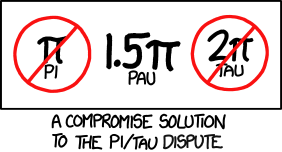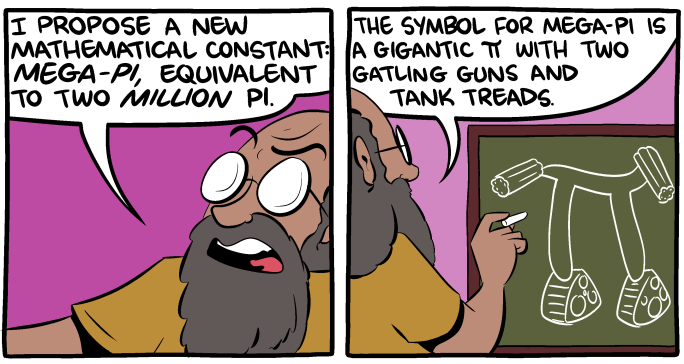Beauty is the first test: there is no permanent place in this world for ugly mathematics.
In 2001, Bob Palais wrote the article π
is wrong!, remarking on the fact that
when π occurs in nature, it occurs as 2π most of the time. He suggests that
2π = 6.283185... should be given a name (τ is now a fan favorite) and that it
should be used instead of π. Some found his arguments convincing, including
Michael Hartl. In 2010, Hartl published The
Tau Manifesto, and the τ movement was born.
- Bob Palais, π is wrong!, 2001, The Mathematical Intelligencer, volume 23, pages 7–8
- Bob Palais' web page
- Michael Hartl, The Tau Manifesto, 2010. As paperback on Amazon
- Joseph Lindenberg, Tau Before It Was Cool, 2011
- Stephen Abbott, Aftermath: My Conversion to Tauism, 2012, Math Horizons, 19(4), p. 34
- Peter Harremoës, Al-Kāshī’s constant, 2018
Articles against τ:
- The Pi Manifesto
- The Proper π Manifesto
- Marc B. Reynolds, Tau and the art of Windmill jousting, 2020
Click to expand
-
2007:
-
2008:
-
2010:
-
2011:
- Jason Palmer, BBC News, 'Tau day' marked by opponents of maths constant pi, 2011
- Elizabeth Landau, CNN, On Pi Day, is 'pi' under attack?, 2011
- Daily Mail, Your number's up: Why mathematicians are campaigning for pi to be replaced with alternate value tau, 2011
- Duncan Geere, Wired, Happy Pi day! Let's kill it, 2011
- Natalie Wolchover, Live Science, Mathematicians Want to Say Goodbye to Pi, 2011
- Drew Grant, Salon, Pi Day threatened by tau protestors, 2011
- Murray Bourne, Interactive Mathematics, Let’s drop pi, 2011
- Debra Black, Toronto Star, Down with ugly pi, long live elegant Tau, physicist urges, 2011
- The Times of India, Life of pi over? 'Tau' may set calculations aright, 2011
- Alessondra Springmann, PCWorld, Tau Day: An Even More Fundamental Holiday Than Pi Day, 2011
- Evann Gastaldo, Newser, Forget Pi, Here Comes Tau, 2011
- Daniel Tovrov, International Business Times, Happy Tau Day!, 2011
- Nancy Haught, The Oregonian, Tau Day today: Mathematicians show their work, 2011
- Nance Haxton, ABC Australia, Push to roll Pi, 2011
- The McGill Daily, Pi is wrong, 2011
- Anqi Shen, phys.org, Math wars: Debate sparks anti-pi day, 2011
- The Telegraph Online, Life of pi in no danger - Experts cold-shoulder campaign to replace with tau, 2011
- Simon Wood, Little Storping-in-the-Swuff, War on Tau, 2011
- Dan Amira, Intelligencer, Pi Is Very Slowly and Nerdily Going Out of Style, 2011
- Sebastian Anthony, Extreme Tech, Down with pi! Today is Tau Day, 2011
- Jacob Aron, New Scientist, Pi's nemesis: Mathematics is better with tau, 2011 (Interview with M. Hartl, subscription required)
- Alasdair Wilkins, Why we have to get rid of pi for the sake of good math, 2011 (interview with M. Hartl)
- Eric Raymond, Tau versus Pi, 2011
- Qiaochu Yuan, Pi is still wrong, 2011
- Ulrich Pontes, Der Spiegel, Physiker will Pi abschaffen, 2011
-
2012:
-
2013:
-
2014:
-
2015:
-
2016:
-
2017:
-
2018:
-
2020:
-
2021:
-
2022:
-
2023:
-
Mathematics Educators StackExchange: Pi or Tau? How should the circle constant be taught?, 2014
-
Theorem of the Day, e.g., Euler’s Identity or Stirling’s Approximation https://theoremoftheday.org/Annex/taumanifesto.html
- Vihart, Pi Is (still) Wrong, 2011
- Michael Blake, What Tau Sounds Like, 2011
- Kevin Houston, Pi is wrong! Here comes Tau Day, 2011
- Matheatre1, 6.283..., 2011
- David Butler, Pi may be wrong, but so is Tau!, 2011 (video)
- Michael Hartl, No, really, pi is wrong: The Tau Manifesto, 2012
- Numberphile, Tau replaces Pi, 2012
- Numberphile, Tau vs Pi Smackdown, 2012
- DerkCopyleft, Tau (6,28...=2Pi) in Pascal's Triangle - Tau en el Triángulo de Pascal, 2014
- Seeker, Is Tau Better Than Pi?, 2014
- Michael Hartl, The Tau Manifesto talk (short version), 2015
- DerkCopyleft, Tau=6,28... and has Perfect Numbers - Tau tiene Números Perfectos, 2015
- Sen Zen, Pi vs Tau, 2016
- Michael Hartl, The Tau Manifesto | Talks at Google, 2017
- QuantumOverlord, Refuting the Pi manifesto on Tau day, 2017
- Vihart, Pi Rant 2018: Alternative Pi
- 3Blue1Brown, How pi was almost 6.283185..., 2018
- HDSQ, Tau the Song with 6.28318 Million Notes, 2019
- BriTheMathGuy, It's Tau Day (but should you care?), 2020
- Mathstreet Boys, Larger Than Pi (Tau Day Parody) | Larger Than Life, 2020
- Khan Academy, Tau versus pi, 2021
- EasyMemory, Writing 1,000 decimals of Tau (2x Pi) from memory, 2021
- sudgylacmoe, The Tau Manifesto - With Michael Hartl, 2023
- Phil A. Smith, Trigonometry With Tau as Circle Constant, 2015
- Phil A. Smith, College Trigonometry With Extensive Use of the Tau Transcendental, 2015
- Michael Hartl, Learn enough Python to be dangerous, 2023
- xkcd, Pi vs. Tau
- xkcd, Symbols
- SMBC, Proposed Number Improvements
- SMBC, Pi-Tau conversion constant
- SMBC, Social
- SMBC, Better than pi
- Crooked Stave Artisan Beer Project, Key Lime Tau (2π)
- Tau Day, June 28, 6/28
- Mike Keith, Pieces of Centaurs: A 768-digit mnemonic for τ = 2π, 2011
- Vitalik Buterin, I'm boycotting pi day because tau day is better, Twitter, 2020
- Elon Musk, tau > pi, Twitter, 2022
(All quotes are translated from the German translation by P. Luckey, 1950.)
While Archimedes was able to bound the ratio of a circle circumference and diameter between 223/71 (≈ 3.1408) and 22/7 (≈ 3.1428), Jamshid al-Kashi wanted to determine it to a much higher precision. In his 1424 Treatise on the circumference of the circle, it was his goal that
in a circle whose diameter is 600,000 times the diameter of the earth, the difference between it [the calculated circumference] and the true circumference is less than a single hair, which is one sixth of the width of an average barley grain, such that it [the difference] in a [circle] which is smaller than that doesn't matter.
This translates to approximately 14 decimal digits.
His calculations are performed in sexagesimal (base 60) digits. In section 8, Transformation of the value of the circumference into the Indian digits under the condition that half of the diameter be one, he gives the result in decimal digits:
We put the digits from left to right onto a half-verse, to get a verse:
wa baḥǧā ḥahǧi ṣaz a za ṭah ḥawahu
muḥīṭun li-quṭrin huwa ’ṯnāni minhu
6 2 8 3 1 8 5 3 0 7 1 7 9 5 8 6 5
is the circumference for a diameter which is two thereof.
Further reading:
- P. Luckey, Der Lehrbrief über den Kreisumfang von Ǧamšīd b. Mas‛ūd Al-Kāšī, 1950
- Peter Harremoës, Al-Kāshī’s constant, 2018
The section Adoption of the symbol π of the excellent Wikipedia article Pi says:

In the earliest usages, the Greek letter π was used to denote the semiperimeter (semiperipheria in Latin) of a circle and was combined in ratios with δ (for diameter or semidiameter) or ρ (for radius) to form circle constants. (Before then, mathematicians sometimes used letters such as c or p instead.) The first recorded use is Oughtred's "δ.π", to express the ratio of periphery and diameter in the 1647 and later editions of Clavis Mathematicae. Barrow likewise used "
$\frac{\pi}{\delta}$ " to represent the constant 3.14..., while Gregory instead used "$\frac{\pi}{\rho}$ " to represent 6.28...The earliest known use of the Greek letter π alone to represent the ratio of a circle's circumference to its diameter was by Welsh mathematician William Jones in his 1706 work Synopsis Palmariorum Matheseos; or, a New Introduction to the Mathematics. The Greek letter first appears there in the phrase "1/2 Periphery (π)" in the discussion of a circle with radius one. However, he writes that his equations for π are from the "ready pen of the truly ingenious Mr. John Machin", leading to speculation that Machin may have employed the Greek letter before Jones. Jones' notation was not immediately adopted by other mathematicians, with the fraction notation still being used as late as 1767.

Euler started using the single-letter form beginning with his 1727 Essay Explaining the Properties of Air, though he used π = 6.28..., the ratio of periphery to radius, in this and some later writing. Euler first used π = 3.14... in his 1736 work Mechanica, and continued in his widely-read 1748 work Introductio in analysin infinitorum (he wrote: "for the sake of brevity we will write this number as π; thus π is equal to half the circumference of a circle of radius 1"). Because Euler corresponded heavily with other mathematicians in Europe, the use of the Greek letter spread rapidly, and the practice was universally adopted thereafter in the Western world, though the definition still varied between 3.14... and 6.28... as late as 1761.
- Processing, since 2.0 (2013)
TAU - Raku (aka Perl 6), since 2015
tau - Nim, since 0.14.0 (2016)
TAU - Python, since 3.6 (2016)
math.tau - Unreal Engine, since 4.12 (2016)
TAU - CSS (2018)
turn - OpenFOAM
twoPi - Extreme Numerics.NET
Constants.TwoPi - V, since 0.1.7 (2019)
tau - Zig, since 0.6.0 (2019)
tau - Manim, since 0.1.0 (2020)
TAU - Rust, since 1.47 (2020)
std::f64::consts::TAU - .NET, C#, since 5.0 (2020)
Tau - Boost, since 1.77.0 (2021)
tau - Godot game engine/GDScript, since 3.3.3 (2021)
TAU - Crystal, since 0.36.0 (2021)
Math::TAU - Java, OpenJDK, since 19 (2022)
Math.TAU - JSCAD, since 2.6.3 (2022)
TAU - Liberty Eiffel, upcoming (202x)
Tau
Inclusion of a constant tau was rejected by the following projects:
- Dart (2011)
- Julia (2013)
- JavaScript (2014)
- Ruby (2016)
- NumPy (2017)
- Go (2020)
- Luau (2022)
- C++ (2022)
With τ being a full revolution, the following identities are very easy to grasp (for integers n). Remember the sine is the projection of the angle onto the y-axis, the cosine is the projection onto the x-axis.
Trigonometric values off the grid can easily be estimated:
- sin(27.4 π) – Where is my calculator?
- sin(13.7 τ) – 13 full revolutions: forget about those. Plus .7, that's almost 3/4 of a revolution, so probably something close to −1. (Actual value: −0.95105651629...)
Note that the Beta function
B, with one argument ½,
includes a factor
Special cases:
-
Volume of the n-dimensional unit ball (λ = 0):
$$|S_n| = \begin{cases} 1 & \text{if } n = 0\\\ 2 & \text{if } n = 1\\\ |S_{n-2}| \times \textcolor{orange}{\tau} / n & \text{otherwise} \end{cases}$$ -
The area of a disk (λ = 0, n = 2)
$$|S_n(r)| = \frac{\textcolor{orange}{\tau}}{2} r^2 = \textcolor{teal}{\pi} r^2$$ -
n = 1, λ = −1/2
$$\int_{-1}^1 \frac{1}{\sqrt{1-x^2}} = \textcolor{teal}{\pi}$$
-
n = 1, λ = 1/2
$$\int_{-1}^1 \sqrt{1-x^2} = \frac{\textcolor{teal}{\pi}}{2}$$
As appearing in its one-dimensional version in the Cauchy distribution and Student's t distribution.
Note again that the Beta function
B, with one argument
½, includes a factor
Compare
One could argue that the latter is more "canonical" since it has variance and standard deviation of 1, not ½ and √½. Compare with the Normal distribution
Let
is completely contained in
Let
-
Positive half-integers:
Γ(½) = √π, so all half-integer values of Γ contain that factor (recall Γ(z+1) = z Γ(z)):
$$\Gamma(n + \tfrac{1}{2}) = \sqrt{\textcolor{teal}{\pi}} \prod_{i=0}^{n-1} \left(i + \frac{1}{2}\right)$$ for n ∈ ℕ. Equivalently:
$$\Gamma(n + \tfrac{1}{2}) = \sqrt{\textcolor{teal}{\pi}} \frac{(2n-1)!!}{2^n}$$ or (for odd n > 0)
$$\Gamma(\tfrac{n}{2}) = \sqrt{\textcolor{teal}{\pi}} \frac{(n-2)!!}{2^{(n-1)/2}}.$$ -
$$\prod_{k=0}^{m-1}\Gamma\left(z+\frac{k}{m}\right) = \textcolor{orange}{\tau}^\frac{m-1}{2} m^{\frac{1}{2}-mz} \Gamma(mz),$$ and its special case (m = 2), the Legendre duplication formula
$$\Gamma(z)\Gamma(z+\tfrac{1}{2}) = 2^{1-2z}\sqrt{\textcolor{teal}{\pi}}\Gamma(2z).$$ -
$$\Gamma(z)\Gamma(1-z) = \frac{\textcolor{teal}{\pi}}{\sin(\textcolor{teal}{\pi} z)}$$
for
A reflection formula:
In statistics, for non-negative values of x, the error function has the
following interpretation: For a random variable Y that is normally
distributed with mean 0 and standard deviation
The sinc function and its power integrals
for all
The Borwein integral
with some rational
-
Cosmological constant:
$$\Lambda = \frac{4\textcolor{orange}{\tau} G}{3c^2} \rho$$ -
Heisenberg's uncertainty principle:
$$\Delta x \Delta p \ge \frac{h}{2 \textcolor{orange}{\tau}}$$ -
Einstein's field equation of general relativity:
$$R_{\mu\nu} = \frac{4\textcolor{orange}{\tau} G}{c^4} T_{\mu\nu}$$ -
Coulomb's law for the electric force in vacuum:
$$F = \frac{|q_1 q_2|}{2\textcolor{orange}{\tau} \varepsilon_0 r^2}$$ -
Magnetic permeability of free space:
$$\mu_0 \approx 2\textcolor{orange}{\tau} \times 10^{-7} N/A^2$$ -
Approximate period of a simple pendulum with small amplitude:
$$T \approx \textcolor{orange}{\tau} \sqrt{\frac{L}{g}}$$ -
Exact period of a simple pendulum with amplitude θ0:
$$T = \frac{\textcolor{orange}{\tau}}{\mathrm{agm}(1, \cos(\theta_0/2))} \sqrt{\frac{L}{g}}$$ (agm is the arithmetic-geometric mean.)
-
Kepler's third law of planetary motion:
$$\frac{R^3}{T^2} = \frac{GM}{\textcolor{orange}{\tau}^2}$$ -
The buckling formula:
$$F = \frac{\textcolor{orange}{\tau}^2 EI}{4L^2}$$ -
Reduced Planck constant:
$$\hbar = \frac{h}{\textcolor{orange}{\tau}}$$ -
Reactance of an inductor:
$$\textcolor{orange}{\tau} fL$$ -
Susceptance of a capacitor:
$$\textcolor{orange}{\tau} fC$$
-

Terence Tao (2007, here):
It may be that 2πi is an even more fundamental constant than 2π or π. It is, after all, the generator of log(1). The fact that so many formulae involving πn depend on the parity of n is another clue in this regard.
-

John Conway (2008, from Constant Failure by Robert P Crease):
[...] I posed this question to the Princeton University mathematician John Conway, one of the most creative mathematicians working today. Conway, it turned out, had strong feelings on the subject. “2π is obviously the correct constant!” he told me immediately — although he also told me of arguments, which he did not find persuasive, for a third option, π/2. [...]
-

Arthur Benjamin (2013, Twitter Q&A):
I’m a big tau lover. I agree with the statement that if we could go back in time and change the factor to tau we would have simplified our theorems and formulas. Obviously, it will be very hard to change people’s perceptions in order to use tau, but maybe in mathematics there is enough of a will to do such a thing. I’ve seen books now that proudly claim “tau certified”.
-

John Baez (2022, from 12 numbers that are cooler than pi):
Using τ makes every formula clearer and more logical than using π. Our focus on π rather than 2π is a historical accident.




